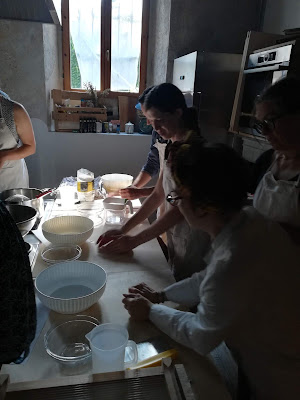Food Matters Study Tour in Milan - Day 2
Day 2
We started the day early in the morning to follow a collection truck and see how households set out their items for collection and are picked up. In Milan there are 5 separate containers for collection: organics, cardboard, glass, plastic and metal, and residual waste. This was impressive since most places in the U.S. only have 2 or 3 separate containers. It takes a lot of effort to educate residents on what goes where and to get them to take the time to do it. Having the space for so many containers is also a challenge most of the time. In Milan, the vast majority of households are in multi-family dwellings (apartment buildings/condos), rather than single family, stand-alone homes. Each building has dedicated space to hold the containers.


 After a coffee break, we visited the headquarters of the waste company, which I found to be one of the most interesting stops of the study tour. I enjoyed hearing about the history of the company, its operations, and its business model. Source-separated food waste collection started in 2012, and after a short grace period, they started fining households that were not separating. The waste company does random samples of bins to make sure everything is sorted correctly and there is a fine for not doing so. The contamination rate is now about 5%, which is pretty remarkable.
After a coffee break, we visited the headquarters of the waste company, which I found to be one of the most interesting stops of the study tour. I enjoyed hearing about the history of the company, its operations, and its business model. Source-separated food waste collection started in 2012, and after a short grace period, they started fining households that were not separating. The waste company does random samples of bins to make sure everything is sorted correctly and there is a fine for not doing so. The contamination rate is now about 5%, which is pretty remarkable. Households store the food waste in biodegradable bags (bio bags) within ventilated caddies kept in the kitchen and then the bags are put into a cart for curbside collection. The organic waste goes to anaerobic digestion facilities, which create biogas and compost. The biogas is upgraded and is delivered into the electricity grid and made into vehicle fuel. Italy has a national goal to increase domestic production of bio-gas.
 We got to visit the company's control food and it was so cool to see their real-time GPS mapping display. All the vehicles were equipped with GPS and routing information. They break the city into four zones with alternate collection
days. There are transfer stations/storage yard in each quadrant. There are also 9,000 smart bins which are designed and
produced by the waste company. They are displayed on the mapping tool to show fullness and if they are blocked.
We got to visit the company's control food and it was so cool to see their real-time GPS mapping display. All the vehicles were equipped with GPS and routing information. They break the city into four zones with alternate collection
days. There are transfer stations/storage yard in each quadrant. There are also 9,000 smart bins which are designed and
produced by the waste company. They are displayed on the mapping tool to show fullness and if they are blocked.That afternoon we learned about EStà (Economia e Sostenibilità) which was the non-profit association that helped plan and organize the company. We also heard about the efforts of a local university a non-profit that rescues produce from farmers and sells it to residents. We purchased some of the "seconds" from the organization and used this beautiful produce to make a real Italian dinner, led by a professional chef in a cooking class. I was so happy to have the chance to make pasta in Italy!







Comments
Post a Comment